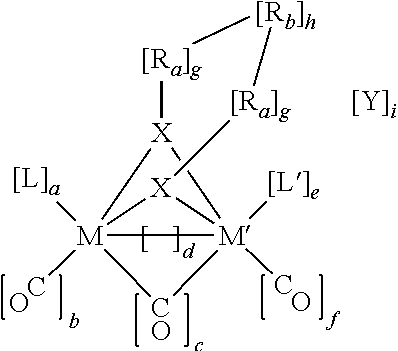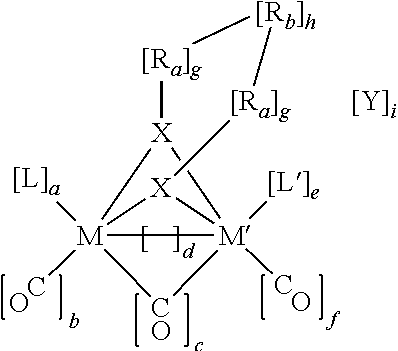Electrocatalytic alkenes and alkynes dimerizations and trimerizations
a technology of electrocatalysis and alkenes, applied in the direction of organic compounds/hydrides/coordination complex catalysts, organic compounds/chemical process catalysts, antimony organic compounds, etc., can solve the problem of not being able to direct oxidation of cyclic alkenes from cyclopenten
- Summary
- Abstract
- Description
- Claims
- Application Information
AI Technical Summary
Problems solved by technology
Method used
Image
Examples
example 1
[0046]Experimental catalysis conditions: 8 mg (20 μmol) of diiron carbonyl catalysts, as listed in Table 2, and 55 mg (500 μmol) of COE (cyclooctene) in 5 mL of 0.05 M to 0.1 M [NBu4][B(C6F5)4] / CH2Cl2 under nitrogen or argon at 293 K to 298 K for 30 min; add 30 mL of hexanes or n-pentane to precipitate supporting electrolyte; filter with M frit, evaporate, extract with ether, hexanes, or n-pentane, and elute with hexane through activated alumina or neutral silica gel, affording 30 mg of a colorless oil shown to be a mixture of dimerized products and their diastereomers.
TABLE 2Diiron carbonyl catalysts.Diiron carbonylcatalystEappNomenclatureEthylene1.0 VM = Fe, M′ = Fe, X = S, a = 2, b = 1, c = 0, d = 1, e = 2, f = 1, g = 1,dithiolateh = 1, i = 0, L = CO, L′ = CO, Ra = CH2 Rb =CH2(p = 0)(A = CH2)(q = 0)CH2(r = 0)Propylene1.0 VM = Fe, M′ = Fe, X = S, a = 2, b = 1, c = 0, d = 1, e = 2, f = 1, g = 1,dithiolateh = 1, i = 0, L = CO, L′ = CO, Ra = CH2 Rb =CH2(p = 0)(A = CH2)(q = 1)CH2(r = ...
example 2
[0048]Experimental catalysis conditions: 7 mg (18 μmol) of diiron carbonyl catalysts (the propyl, butyl, and pentyl thiolate catalysts listed in Table 2) and 10 mg (98 μmol) of phenylacetylene in 5 mL of 0.05 M to 0.1 M [NBu4][B(C6F5)4] / CH2Cl2 under nitrogen or argon; potentiostatic electrolyze (Eapp=1 V when carbonyl of diiron carbonyl catalyst is propyl dithiolate; Eapp=0.9 V when carbonyl of diiron carbonyl catalyst is butyl dithiolate; and Eapp=0.7 V when carbonyl of diiron carbonyl catalyst is pentyl dithiolate) at 293 K to 298 K for 30 min; add 30 mL of hexanes or n-pentane to precipitate supporting electrolyte; filter with M frit, evaporate, extract with ether, hexanes, or n-pentane, and elute with hexane through activated alumina or neutral silica gel, affording 30 mg of a beige oil shown to be a mixture of dimerized products. Dimerized products of phenylacetylene are generally characterized as C16 compounds. Mass: cis and trans PhCH═CH—CECPh, M+ at m / z=204; the gas chromato...
example 3
[0049]Experimental catalysis conditions: 7 mg (18 μmol) of diiron carbonyl catalysts (the propyl, butyl, and pentyl thiolate catalysts listed in Table 2) and 54 mg (658 μmol) of cyclohexene in 5 mL of 0.05 M to 0.1 M [NBu4][B(C6F5)4] / CH2Cl2 under nitrogen or argon; potentiostatic electrolyze (Eapp=1 V when carbonyl of diiron carbonyl catalyst is propyl dithiolate; Eapp=0.9 V when carbonyl of diiron carbonyl catalyst is butyl dithiolate; and Eapp=0.7 V when carbonyl of diiron carbonyl catalyst is pentyl dithiolate) at 293 K to 298 K for 30 min; add 30 mL of hexanes or n-pentane to precipitate supporting electrolyte; filter with M frit, evaporate, extract with ether, hexanes, or n-pentane, and elute with hexane through activated alumina or neutral silica gel, affording 30 mg of a colorless oil shown to be a mixture of dimerized and trimerized products. Dimerized products are generally characterized as C12 compounds. Trimerized products are generally characterized as C18 compounds. All...
PUM
| Property | Measurement | Unit |
|---|---|---|
| diastereomers | aaaaa | aaaaa |
| voltage | aaaaa | aaaaa |
| temperature | aaaaa | aaaaa |
Abstract
Description
Claims
Application Information
 Login to view more
Login to view more - R&D Engineer
- R&D Manager
- IP Professional
- Industry Leading Data Capabilities
- Powerful AI technology
- Patent DNA Extraction
Browse by: Latest US Patents, China's latest patents, Technical Efficacy Thesaurus, Application Domain, Technology Topic.
© 2024 PatSnap. All rights reserved.Legal|Privacy policy|Modern Slavery Act Transparency Statement|Sitemap



